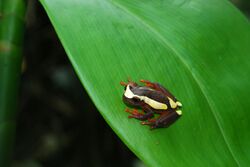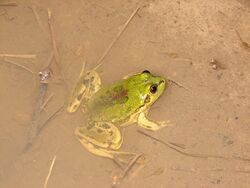Biology:Dendropsophini
| Dendropsophini | |
|---|---|

| |
| Dendropsophus bifurcus | |

| |
| Pseudis bolbodactyla | |
| Scientific classification | |
| Domain: | Eukaryota |
| Kingdom: | Animalia |
| Phylum: | Chordata |
| Class: | Amphibia |
| Order: | Anura |
| Family: | Hylidae |
| Subfamily: | Hylinae |
| Tribe: | Dendropsophini Fitzinger, 1843 |
| Type genus | |
| Dendropsophus Fitzinger, 1843
| |
| Genera | |
|
8 genera (see text) | |
| Synonyms | |
| |
Dendropsophini is a tribe of small neotropical tree frogs in the subfamily Hylinae. They are distributed from southern Mexico, throughout Central America, and down South America (including Trinidad) to northern Argentina and Uruguay. Removed from the synonymy of Hylinae in 2016,[1] this taxon was formerly considered its own subfamily before being reclassified as a tribe.[2] As defined by Favovich et al. in 2005, the tribe Dendrosophini contains the members of three former subfamilies within the Hylidae prior to taxonomic rearrangement: Dendropsophinae, Pseudinae, and Scinaxinae.[3]
Taxonomy
Genera
There are eight genera in the tribe Dendropsophini:[1][3][4][5]
- Xenohyla Sphaenorhynchus
- Pseudis Dendropsophus
- Fitzinger, 1843 Duellman, Marion & Hedges, 2016
- Wagler, 1830 Izecksohn, 1998
- Scarthyla Lysapsus
- William Edward Duellman and de Sá, 1988 Tschudi, 1838
- Julianus Cope, 1862
- Wagler, 1830 Scinax
Evolution
The tribe name comes from the Greek word dendron which means "tree" and psophos which means "sound" or "noise," referring to how some of these frogs are more easily heard from up in the trees than seen. They first evolved during the Eocene 39.1–50.8 Mya and diversifying during the early Oligocene 25.3–38.5 Mya.[1]
The sister taxon of the pseudines (formerly the subfamily Pseudinae) are the dendropsophines (containing only Dendropsophus and Xenohyla), splitting apart from them during early Oligocene 25.8–38.7 Mya. Dendropsophines remained tree frogs and diversified greatly, while Pseudine frogs transitioned to aquatic ecosystems. Scarthyla is the oldest and most hylid-like of the pseudines, originating in the central Amazon basin and being restricted to the Guiana region in modern times. Lysapsus and Pseudis diverged during the early Miocene 18.4–24.6 Mya and have since spread down to the Chaco region that is drier and less suited for most tree frogs. Scinaxine frogs evolved approximately 42.0–56.4 Mya during the Oligocene. The most primitive of the Scinaxine frogs is Sphaeorhynchus, which remained in the Atlantic Coastal Forest of Brazil while the other lineages evolved into Julianus in the southeast, Ololygon also in the Atlantic Coastal Forest, and Scinax in the Amazon Basin.[6]
Description
There are only two dendropsophines. Xenohyla is confined to only coastal Brazil , while the range of Dendropsophus is much larger. Xenohyla has 2n=24 chromosomes while Dendropsophus has 2n=30 chromosomes.[1]
Pseudines are notable for because despite being tree frogs, they have convergently evolved with true frogs and have lost most of their tree dwelling traits, becoming semi-aquatic or aquatic.[7] Their name references this similarity, with Pseudis coming from the Greek ψεῦδος (pseudos) which means "false" or "pretending". This is evident in how the intercalary elements, which are the spaces in between a frog's digits, have become ossified in order to strengthen them and help them swim in the water more efficiently. Normally in tree frogs, these intercalary elements remain unossified in order to allow their hands and feet to be flexible.[6][8] They also have a unique ligament cap that connects their knee to their pelvis that has not yet been seen in any other type of frog.[9] These frogs have a chromosome component of 2n = 24, the exceptions being Scarthyla goinorum with 2n = 22 and Pseudis cardosoi with 2n = 28.[10] In the wild they are preyed on by a variety of animals, including aquatic insects, spiders, and birds such as the buff-necked ibis and large-billed tern.[11]
The scinaxines are small to medium-sized frogs with pointy snouts, and often stowaway on products such as house plants and fruit. Because of this, two species of Scinax have been introduced outside of their native range, with Scinax quinquefasciatus on the Galapagos Islands[12] and Scinax ruber on St. Lucia, Martinique, and Puerto Rico.[13]
References
- ↑ 1.0 1.1 1.2 1.3 Duellman, William E.; Marion, Angela B.; Hedges, S. Blair (2016). "Phylogenetics, classification, and biogeography of the treefrogs (Amphibia: Anura: Arboranae)". Zootaxa 4104 (1): 1–109. doi:10.11646/zootaxa.4104.1.1. PMID 27394762.
- ↑ "Hylinae Rafinesque, 1815 | Amphibian Species of the World" (in en). https://amphibiansoftheworld.amnh.org/Amphibia/Anura/Hylidae/Hylinae.
- ↑ 3.0 3.1 Julián., Faivovich; B., Haddad, Célio F.; A., Garcia, Paulo C.; R., Frost, Darrel; A., Campbell, Jonathan; Ward., Wheeler (2005) (in en-US). Systematic review of the frog family Hylidae, with special reference to Hylinae : phylogenetic analysis and taxonomic revision. Bulletin of the AMNH ; no. 294. https://digitallibrary.amnh.org/handle/2246/462.
- ↑ Frost, Darrel R. (2020). "Dendropsophinae Fitzinger, 1843". Amphibian Species of the World: An Online Reference. Version 6.1 (American Museum of Natural History). doi:10.5531/db.vz.0001. https://amphibiansoftheworld.amnh.org/Amphibia/Anura/Hylidae/Dendropsophinae. Retrieved 30 July 2020.
- ↑ "Hylinae Rafinesque, 1815 | Amphibian Species of the World" (in en). https://amphibiansoftheworld.amnh.org/Amphibia/Anura/Hylidae/Hylinae.
- ↑ 6.0 6.1 Duellman (19 April 2016). "Phylogenetics, classification, and biogeography of the treefrogs (Amphibia: Anura: Arboranae)". Zootaxa 4104 (1): 1–109. doi:10.11646/zootaxa.4104.1.1. PMID 27394762. http://www.cnah.org/pdf/88524.pdf.
- ↑ Duellman (19 April 2016). "Phylogenetics, classification, and biogeography of the treefrogs (Amphibia: Anura: Arboranae)". Zootaxa 4104 (1): 1–109. doi:10.11646/zootaxa.4104.1.1. PMID 27394762. http://www.cnah.org/pdf/88524.pdf.
- ↑ Manzano (December 2007). "Intercalary elements, treefrogs, and the early differentiation of a complex system in the Neobatrachia". The Anatomical Record 290 (12): 1551–1567. doi:10.1002/ar.20608. PMID 17957750. https://anatomypubs.onlinelibrary.wiley.com/doi/10.1002/ar.20608.
- ↑ Manzano (September 2005). "The iliosacral articulation in Pseudinae (Anura : Hylidae)". Herpetologica 61 (3): 259–267. doi:10.1655/04-28.1. https://www.researchgate.net/publication/250069333.
- ↑ Duellman (19 April 2016). "Phylogenetics, classification, and biogeography of the treefrogs (Amphibia: Anura: Arboranae)". Zootaxa 4104 (1): 1–109. doi:10.11646/zootaxa.4104.1.1. PMID 27394762. http://www.cnah.org/pdf/88524.pdf.
- ↑ Filho (April 2019). "Escape or be Preyed: New Records and Current Knowledge on Predators of Pseudinae Frogs (Anura: Hylidae) in South America". Acta Biológica Colombiana 24 (2): 397–402. doi:10.15446/abc.v24n2.74650. https://www.researchgate.net/publication/332763973.
- ↑ "Scinax quinquefasciatus Fowler, 1913". https://www.darwinfoundation.org/en/datazone/checklist?species=5022.
- ↑ "Scinax ruber (Laurenti, 1768)". 18 April 2019. https://nas.er.usgs.gov/queries/factsheet.aspx?SpeciesID=978.
Wikidata ☰ Q27975540 entry
 |

